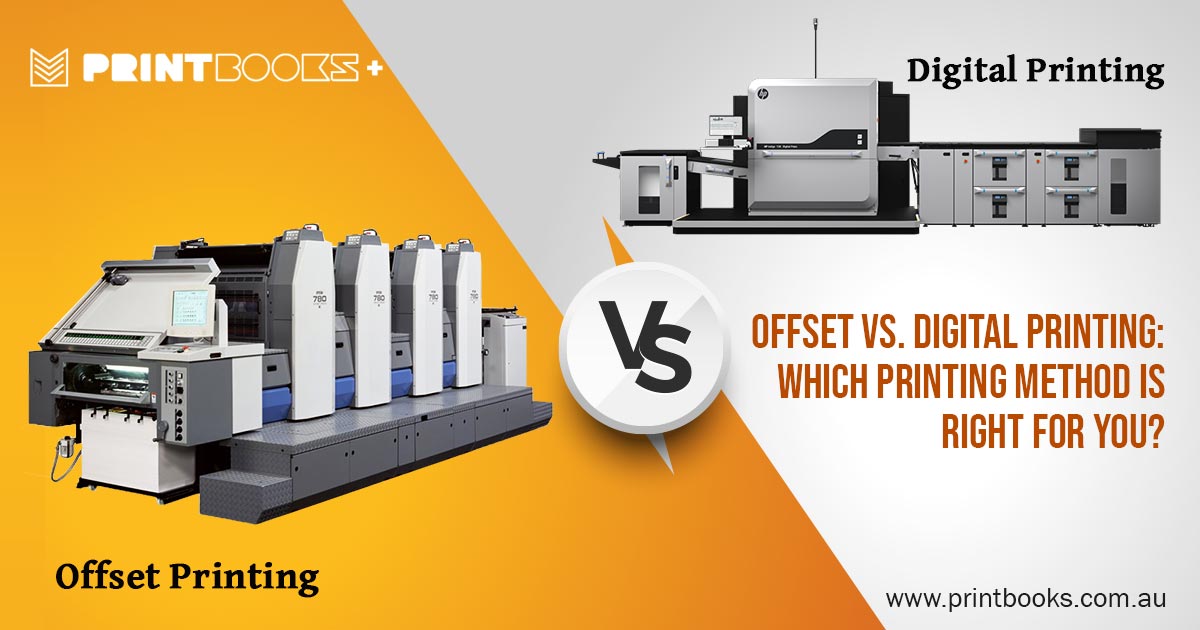Offset vs. Digital Printing: Which printing method is right for you?

If you’re in the market for brochures, business cards, posters, or other marketing materials, you already know how imperative it is to create the right style, colour scheme, copy, and layout. There is still one more crucial choice to make: choosing between digital and offset printing.
Is digital printing superior to offset printing? It’s a common question, yet the response is not as simple and straightforward as you might expect. Naturally, the answer is either “yes or no”, but it really does depend on your printing needs. To determine which is superior for printing your marketing materials, let’s examine the distinctions between offset printing and digital printing.
For decades, offset printing which has been around for more than a century was the ideal method for printing nearly all commercial materials, including newspapers, magazines, booklets printing, advertising, postcards, and brochures. Ink is often transferred from a plate to a rubber sheet in offset printing, which subsequently rolls the ink onto paper, vinyl, or another surface. Digital printing, on the other hand, does not utilise plates to transfer ink to paper.
We’ll discuss the distinctions between the two printing methods in this blog and illustrate their advantages and disadvantages. We’ll also provide a list of the considerations you should make while deciding on the appropriate procedure for your job so that you may obtain the best idea of how both digital and offset printing works.
How Offset Book Printing Works
The most frequent printing method used for big volume commercial tasks is offset printing, often known as lithography. Have you ever seen videos of newspapers being rolled up in large rolls? That is what offset printing looks like.
This is how it goes: one metal plate is burned with the design by the printer for each colour. Offset printing enables the use of unique ink colours, most notably Pantone colours, in addition to the conventional four colours (cyan, magenta, yellow, and black (key), or CMYK).
After that, rubber rollers receive the design from the plates. The various ink shades are applied to the rubber, and the paper is then passed through them. To create the final image, the paper layers on colour as it moves through each roll.
Advantages of choosing offset printing
Superior and trustworthy image quality:
Offset printing delivers clear, distinct letters and images free of smudges or blemishes.
Better Colour Fidelity:
This is also known as colour accuracy and colour balance in the design and relates to the correctness of the colours. Offset printing will naturally produce accurate colour since it can mix unique colour inks for each project.
Equally effective on all materials:
This type of printing allows you to have a plethora of materials to choose from without losing out on any quality.
Cost-effective:
You get more value for your money on projects with high volume. An offset work starts out very expensive. The plates must be made, which costs money and requires time. Once you’ve invested the money, though, all the materials are prepared, and you’ll spend less on large offset works than on digital prints, which cost roughly the same per piece regardless of how big the job gets.

Disadvantages of Offset Printing
Not fit for low-volume projects
With offset printing, low-volume jobs are expensive due to the initial setup costs.
Time-consuming
You might be stuck with a longer schedule since the plates need to be made.
Worse Fallout
A batch is difficult to repair as you must start the procedure all over again if you miss a typo on a plate, leading to worse consequences in the event of a mistake.
How Digital Book Printing Works
Digital printing more user-friendly. Recall the offset printing pre-press set-up? With digital printing, the entire step vanishes. Instead, one of two techniques, laser or inkjet is employed by these printers. The internal operations of the machine are a little more complex. In general, it entails dotting hundreds of dots of colour directly onto the paper.
Instead of using plates like offset printing does, digital printing can also use toner (found in laser printers) or larger printers that use liquid ink. When printing in smaller quantities, such as a run of 20 greeting cards or 100 flyers, digital printing excels. The capacity to print with varied data is another advantage of digital printing. Each component requires a distinct code, name, or address. This need cannot be met by offset printing.
While offset printing is a great way to create stunning print projects, the best option for many organisations or individuals who don’t need big quantities of 500 or more is digital printing.
Benefits of digital printing
Quick printing:
The lack of a setup process allows for a faster turnaround time.
Identical Printing:
Every print is the same. You have a lower danger of variances brought on by ink and water imbalances.
Perfect for Low volume:
While it is the most cost-effective solution for when you don’t have too many copies to print, the costs eventually criss-cross because offset printing has a lower cost per unit.
Customising certain fields:
Digital printing allows you to alter certain fields in each single copy, making it perfect for invites, tickets and other materials that require personalisation.
Disadvantages of Digital Printing
Lack of materials
There are fewer choices for the materials you can print on.
High cost for high volume
Digital printing is not suitable for massive projects
Lower Quality
In comparison, digital printing has less sharpness, crispness, and quality.
Conclusion
Whether you choose Offset or Digital printing, it depends on the type of project you’re working on. If you still have questions, our team here at Print Books make book printing in Australia much easier. We are happy to help and provide our 20+ years of experience in digital book printing and hardback printing. We’re the top booklet printers in Melbourne, and pride ourselves in the expertise and service we provide.
Have your manuscript ready?
